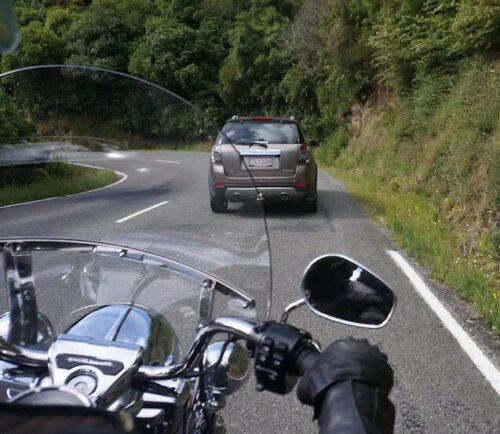Getting your snowmobile’s track adjusted correctly doesn’t have to be complicated. In this guide, we’ll show you the tools, step-by-step instructions, and troubleshooting tips for all major brands — Polaris, Ski‑Doo/Lynx, Arctic Cat, Yamaha, and more. If you do it right, your snowmobile will run great quickly. Why Track Tension Matters Track tension directly affects […]

10 Dangerous Motorcycle Habits You Need to Break Now
Motorcycling is an exhilarating experience, offering freedom, adventure, and a unique connection to the road. However, even seasoned riders can develop dangerous habits that compromise safety and performance. In this comprehensive guide, we’ll explore the most common dangerous motorcycle habits, why they’re dangerous, and how to fix them. Whether you’re a new rider or a veteran, breaking these habits could save your life.
Table of Contents
1. Skipping Protective Gear
The Habit: Riding without a helmet, gloves, jackets, or proper footwear.

riding a motorcycle without protective gear
Why It’s Dangerous:
Motorcycle riding exposes you to greater risks in crashes, including head injuries and traumatic brain injuries. Helmets and protective clothing are essential for protection while wearing these items can prevent cuts, bruises, and road rash.
The National Highway Traffic Safety Administration (NHTSA) reports that helmets reduce the risk of death by 37% and head injury by 69%. Yet, many riders skip gear for “short trips” or comfort.
The Fix:
- Always wear a DOT/ECE-certified helmet. Modern helmets are lightweight and ventilated.
- Invest in abrasion-resistant jackets, pants, and gloves. Look for CE-rated armor.
- Choose boots that cover ankles. Sneakers offer zero protection in crashes.
Pro Tip: Use gear with reflective materials for better visibility at night.
2. Speeding and Overconfidence
The Habit: Riding too fast for conditions or showing off with risky maneuvers.
Why It’s Dangerous:
Speeding and overconfidence are common temptations for motorcyclists, leading to unnecessary risks and accidents. Speeding reduces the time for reactions, increases stopping distances, and reduces the margin for error. Overconfidence can blind riders to potential hazards, leading to misjudgments and potential legal consequences. It's crucial for motorcyclists to stay aware of their surroundings and maintain a safe speed to protect themselves and others on the road.
The Fix:
- Follow speed limits and adjust for weather, traffic, and road quality.
- Practice slow-speed maneuvers in empty parking lots.
- Take advanced riding courses (e.g., MSF Advanced RiderCourse).
Did You Know? ABS (Anti-lock Braking Systems) can reduce fatal crashes by 31% (IIHS).
3. Neglecting Motorcycle Maintenance

motorcycle maintenance is necessary
The Habit: Ignoring tire pressure, chain lubrication, brake checks, or oil changes.
Why It’s Dangerous: Worn tires cause poor traction. Faulty brakes or loose chains can lead to mechanical failure mid-ride.
The Fix:
- Check tire pressure weekly. Underinflated tires reduce stability.
- Lubricate the chain every 500 miles.
- Replace brake pads if the thickness is below 1/8 inch.
- Follow the manufacturer’s maintenance schedule.
Pro Tip: Use a motorcycle maintenance app (e.g., Drivvo) to track service dates.
4. Lane Splitting Unsafely
The Habit: Weaving between cars at high speeds or in heavy traffic.
Why It’s Dangerous: While lane splitting is legal in some states (e.g., California), doing it recklessly can cause collisions. Drivers often don’t expect motorcycles in tight spaces.
The Fix:
- Only lane split if it’s legal in your state.
- Keep speeds under 10 mph faster than traffic.
- Avoid splitting near large vehicles (trucks, buses).
- Watch for car doors opening or sudden lane changes.
Did You Know? California’s lane-splitting guidelines recommend not exceeding 30 mph.
5. Riding Distracted

riding distracted is dangerous
The Habit: Using phones, adjusting GPS, or daydreaming while riding.
Why It’s Dangerous: A 2023 study by AAA found that riders who text are 8x more likely to crash. Distractions delay reaction time.
The Fix:
- Mount your phone/GPS securely and use voice commands.
- Pull over to adjust settings or check directions.
- Stay mentally focused—avoid “autopilot” mode on familiar routes.
Pro Tip: Use Bluetooth helmet communicators for hands-free calls.
6. Poor Body Positioning
The Habit: Leaning incorrectly in turns, gripping handlebars too tightly, or slouching.
Why It’s Dangerous: Bad posture reduces control and increases fatigue. Improper leaning raises the risk of low siding.
The Fix:
- Look through turns—your head and eyes guide the bike.
- Relax your grip; use your knees to grip the tank.
- Shift your weight to the inside footpeg during turns.
Pro Tip: Watch YouTube tutorials by certified instructors for visual guidance.
7. Tailgating or Following Too Closely

keeping proper following distance to avoid danger
The Habit: Riding too close to the vehicle ahead.
Why It’s Dangerous: Motorcycles need more stopping distance than cars. Tailgating leaves no room to react to sudden stops.
The Fix:
Follow the “3-second rule”: Pick a marker, and ensure 3 seconds pass before you reach it.
Increase distance in rain, fog, or gravel.
Did You Know? A motorcycle traveling at 60 mph needs 120–140 feet to stop (MSF).
8. Ignoring Blind Spots
The Habit: Lingering in car or truck blind spots.
Why It’s Dangerous: Drivers won’t see you, increasing the risk of sideswipes or lane-change collisions.
The Fix:
- Stay visible: Ride in the left or right third of the lane.
- Pass quickly if you’re near a vehicle’s blind spot.
- Use your horn or rev the engine to alert drivers.
Pro Tip: Install auxiliary lights to improve visibility.
9. Riding Under the Influence

Don't get drunk before riding a motorcycle
The Habit: Consuming alcohol, drugs, or medications before riding.
Why It’s Dangerous: Alcohol impairs balance, judgment, and coordination. In 2021, 29% of fatally injured riders were alcohol-impaired (NHTSA).
The Fix:
- Never drink and ride. Use ride-sharing apps instead.
- Check medication labels for drowsiness warnings.
- Stay hydrated—dehydration mimics alcohol impairment.
Did You Know? A blood alcohol concentration (BAC) of 0.08% reduces reaction time by 20–40%.
10. Failing to Signal or Communicate
The Habit: Not using turn signals, hand gestures, or brake lights properly.
Why It’s Dangerous: Drivers rely on your signals to anticipate moves. Sudden lane changes confuse traffic.
The Fix:
- Use turn signals 100–200 feet before turning.
- Flash brake lights before slowing down.
- Use hand signals (e.g., pointing to hazards) to communicate with riders.
Pro Tip: Install self-canceling turn signals to avoid leaving them on accidentally.
Bonus: How to Break Dangerous Motorcycle Habits
- Self-Assess: Record your rides or ask a friend to critique your habits.
- Practice Mindfulness: Stay conscious of your actions—no autopilot!
- Take a Refresher Course: Many organizations offer advanced training.
Final Thoughts
Getting over lousy bike-riding habits ain't quick, but man, it's worth it. You score safer treks, dodge more scrapes, and just dig the ride heaps more. Keep up with the know-how, make sure you’re seen, and put bike upkeep at the top of your list.
Don’t forget minor tweaks such as a weekly tire pressure check, could be a game-changer for staying alive.
You may also be interested in: Top 3 Motorcycle Dangers and Prevention Strategies

Rodney L is a technical writer and product consultant with over a decade of experience in the motor industry. Rodney is a fan of performance machines that run fast and loud and an expert in all things custom. His numerous articles and write-ups are available at our knowledge base. Whether it’s something wrong with your motorcycle or you are building a custom bike, you can trust Rodney’s experience.
Motorcycle riding is all about the sense of freedom, adventure, and thrill of the open road. But come on—being connected when you ride isn't always an easy thing. Whether you're riding with a buddy, navigating traffic in the city, or long-distance riding, effective communication is crucial. That's where the Fodsports T5 and T6 come in, […]
If you're looking for a new motorcycle intercom system this year, Fodsports has something exciting in store. The company has launched two new Bluetooth helmet intercoms: T1 and T1 Pro. Both models bring upgraded features, sleek design, and high-definition audio quality for riders who want to stay connected, entertained, and safe on the road. But […]
Fodsports T1 and T1 Pro: The Newest Bluetooth Intercoms for Riders Shop Fodsports T1 Pro Whether you’re cruising on highways, exploring rugged trails, or commuting daily, clear communication is key. Fodsports is thrilled to launch its latest Bluetooth intercoms: the T1 and T1 Pro. Built for riders who demand reliability, versatility, and crystal-clear sound, these […]
Many riders who aren't so tall or ladies just starting to ride bikes need to pick out the best Motorcycles for Short Riders and Women. They gotta look for three key things: a seat that's not too high up, a bike that's not too heavy, and something that looks good enough to give them confidence. […]
Fodsports FX 60C vs FX30C Pro: What's new techs are the FX 60C bringing to us? Fodsports is a brand worth-mention for helmet communication and video recording. This brand has established itself as a key player with its innovative Bluetooth camera intercom systems. Recently, Fodsports has released a new camera intercom, the FX 60C. How […]

